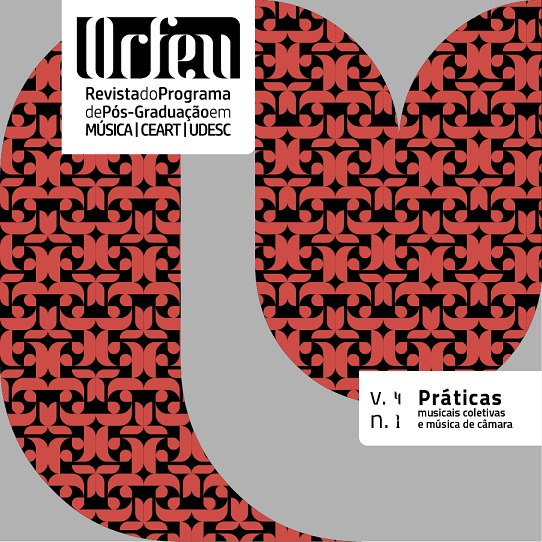The digital modeling of the “viola caipira” tone as a basis for the composition of Bestiary III
DOI:
https://doi.org/10.5965/2525530404012019166Keywords:
Brazilian Folk Guitar, Csound, Physical Modeling, Karplus-Strong Synthesis, Mixed Eletroacoustic MusicAbstract
In a partial perspective, this is a report about experiments that aimed to produce the synthesis of sounds similar to a Brazilian folk guitar, using variations of the Karplus-Strong method. Delay-lines implementing the waveguide model are the basis of this sound synthesis method. Therefore, this study belongs to the field of physical modelling. The departing point of the developed variants were the algorithms of Lazzarini et al. (2016) e Mikelson (2000). In a broader perspective, this study searches to incorporate to the model other characteristics of the acoustic instrument, as the double strings strikes, modal components, formants and the resonance of the instrument’s body. The resulting hybrid algorithm incorporated a variety of other methods, as the synthesis by sum of sine waves plus noise of Serra (1997) and the FOF technique described by Clarke (2000). The research of Paiva (2017) provided experimental values used in the model parametrization. The results were used to compose the piece Bestiário III for guitar and electronic sounds generated after the viola caipira model. The pitch matrix and the proportions of the complex rhythms were loosely inspired by Paiva’s (2017) spectral analysis of the viola caipira.
Downloads
References
COELHO DE SOUZA, R. The use of Brazilian folk instrument sounds in a concerto for computer and orchestra. Organised Sound. v. 10, p.31-36. 2005.
COELHO DE SOUZA, R. Um modelo de kalimba em Csound usado em O Livro dos Sons. Música Hodie, v. 11, p.87-102. 2011.
COELHO DE SOUZA, R. Harmonic perception and voice leading spaces of set classes related by unordered interval classes. Musica Theorica v. 3, n. 2, p.46-85. 2019.
CLARKE, M. FOF and FOG Synthesis in Csound. In: BOULANGER, R. (ed.). The Csound Book: perspectives in software synthesis, sound design, signal processing and programming. Cambridge, MA: The MIT Press. 2000.
CORRÊA, R. N. Viola caipira: das práticas populares à escritura da arte. Tese de doutorado em Musicologia. Escola de Comunicações e Artes. Universidade de São Paulo. São Paulo. 2014.
DE POLI, G.; ROCCHESSO, D. Physically based sound modelling. Organised Sound v. 3, n. 1, p.61-76. 1998.
FLETCHER, N; ROSSING, T. The Physics of Musical Instruments. 2 ed. New York: Springer. 1998.
HENRIQUE, L. L. Instrumentos Musicais. Lisboa: Fundação Calouste Gulbenkian. 2004.
KARPLUS, K.; STRONG, A. Digital synthesis of plucked string and drum timbres. Computer Music Journal, v. 7, n. 2. 1983.
KELLER, D.; FERNEYHOUGH, B. Analysis by modeling: Xenakis’s ST/10-1 080262. Journal of New Music Research, v. 33, n. 2, p.161-171. 2004.
LAZZARINI, V; YI, S.; FFITCH, J.; HEINTZ, J.; BRANDTSEGG, O.; McCURDY, I. Csound: a sound and music computing system. Cham, Switzweland: Springer. 2016.
LOY, G. 2007. Musimathics: the mathematical foundations of music, v. 2. Cambridge, MA: The MIT Press. 2007.
MIKELSON, H. Mathematical modeling with Csound: from waveguides to caos. In: BOULANGER, R. (ed.). The Csound Book: perspectives in software synthesis, sound design, signal processing and programming. Cambridge, MA: The MIT Press. 2000.
PAIVA, G. O. Vibroacoustic characterization and sound synthesis of the viola caipira. Tese de doutorado - Faculdade de Engenharia Mecânica. UNICAMP. Campinas. 2017.
SERRA, X. Musical sound modeling with sinusoids plus noise. In: ROADS, C. (ed.). Musical Signal Processing. Lisse: Swets & Zeitlinger. 1997.
SMITH III, J. O. Physical Audio Signal Processing: for virtual musical instruments and digital audio effects. Stanford: W3K Publishing. 2010.
Downloads
Published
How to Cite
Issue
Section
License
Copyright (c) 2019 ORFEU

This work is licensed under a Creative Commons Attribution 4.0 International License.
Authors who submit their manuscripts to be published in this journal agree to the following terms:
1. Authors retain the copyright and grant to the journal the right of first publication, whilst simultaneously permitting their work to be licensed under the Creative Commons License Attribution, which allows the sharing of work with recognition of the authorship and initial publication in this journal.
2. Contributions in this journal are open access; this means they are based in free use, and non-commercial applications.






